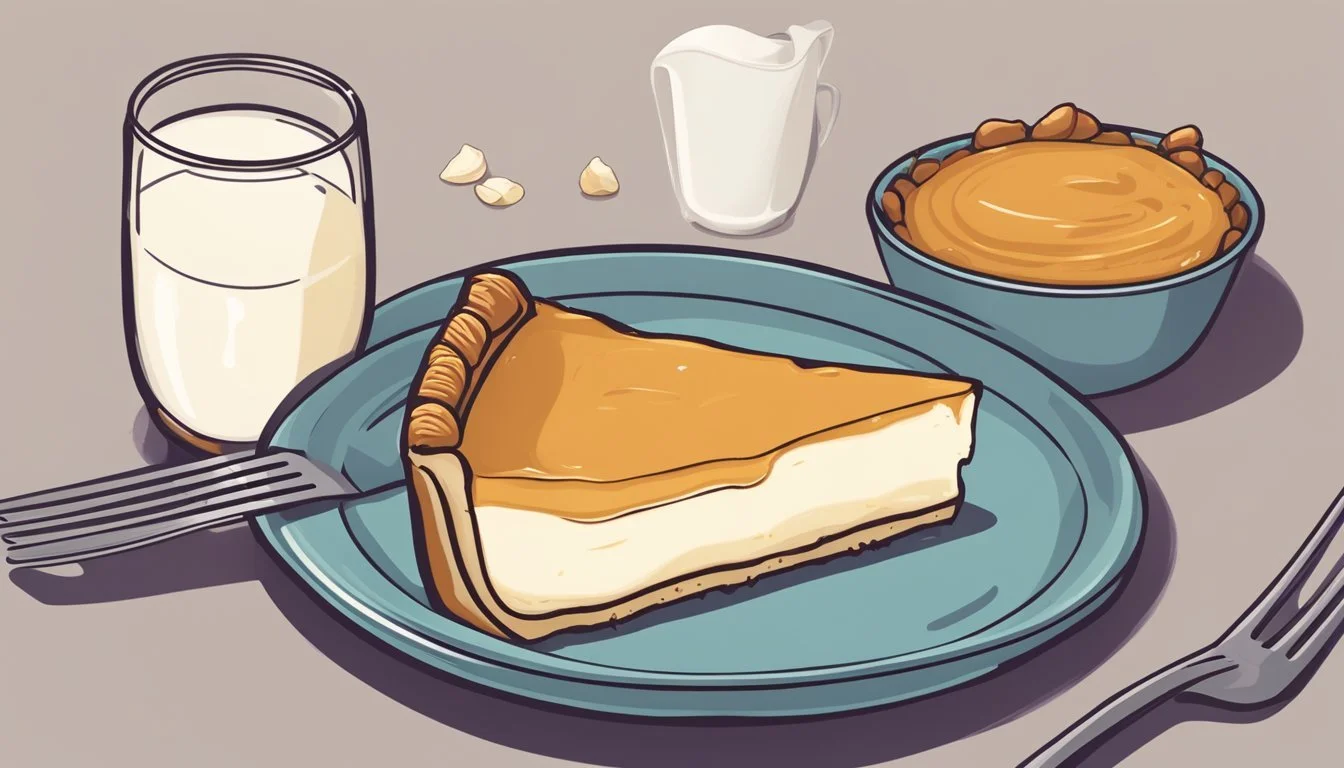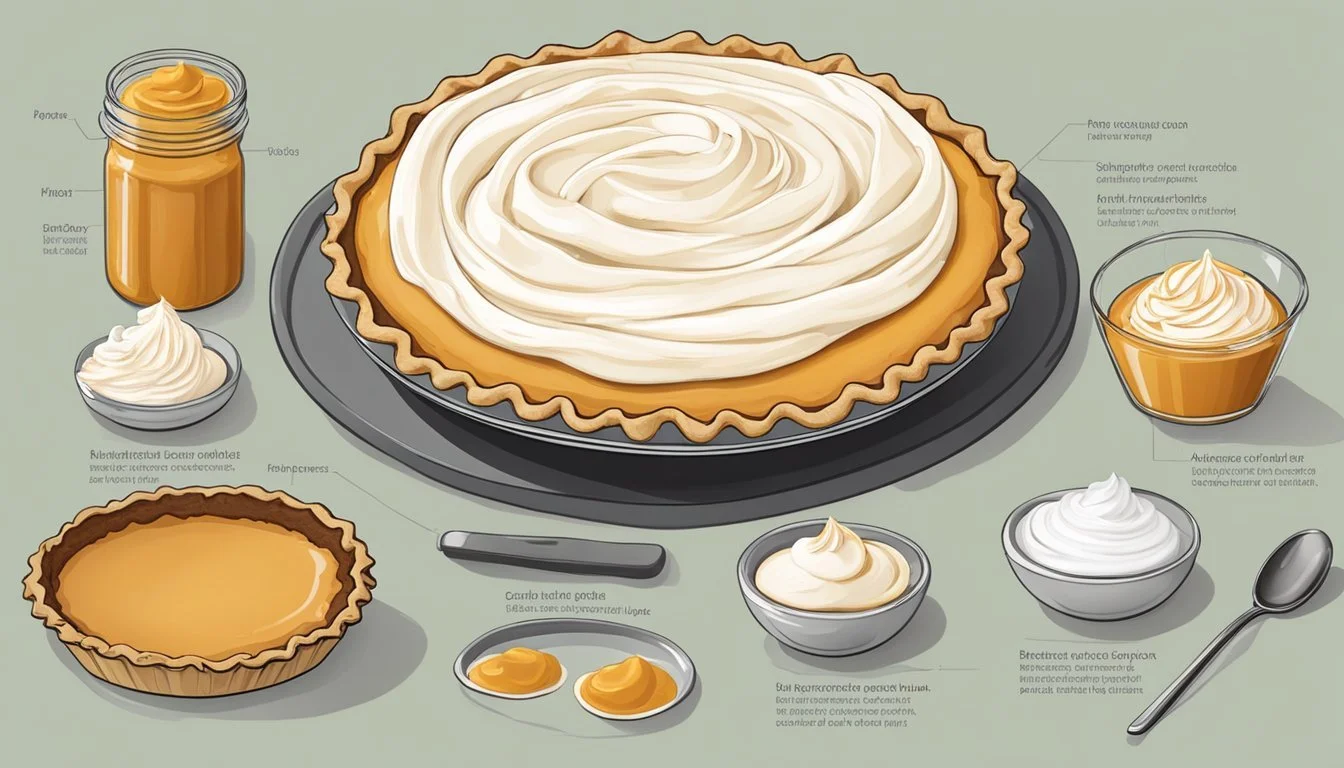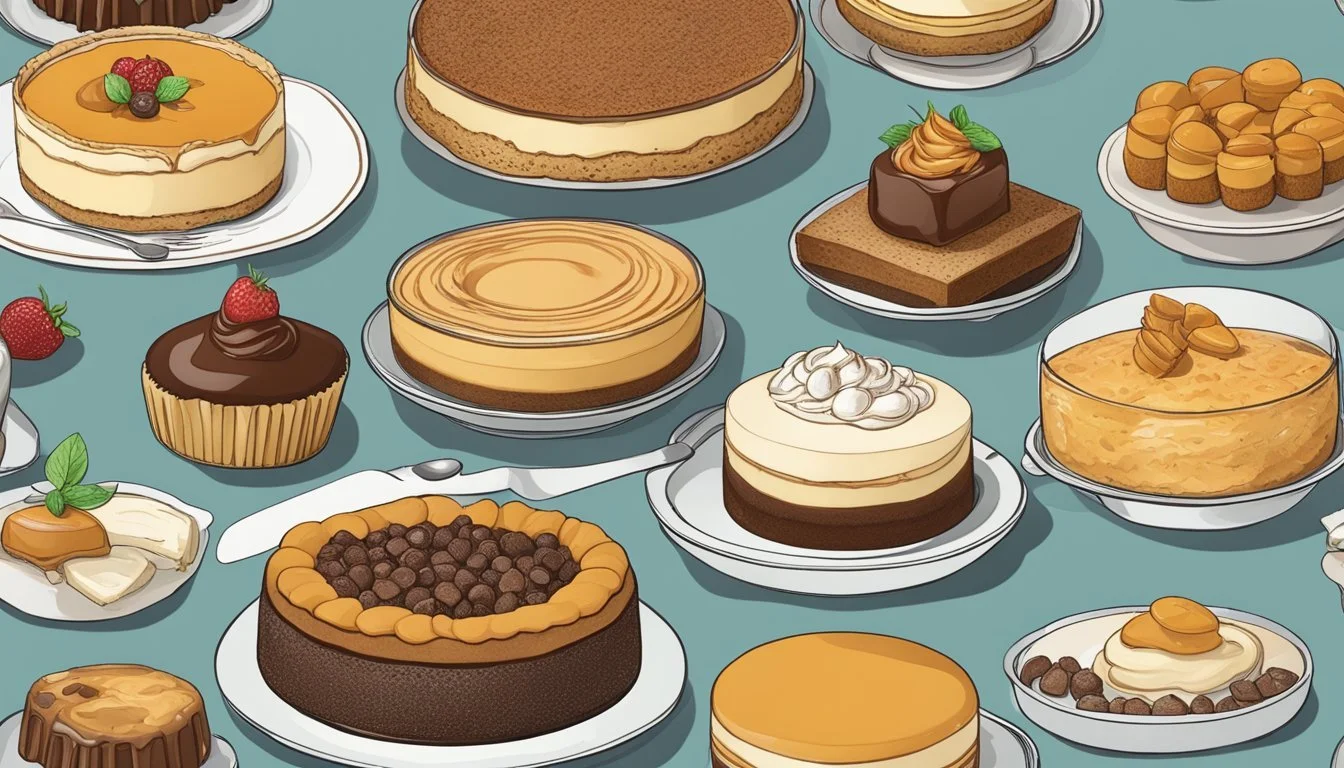Is Butterscotch Pie Vegan?
Decoding Dessert Ingredients
When inquiring whether butterscotch pie is vegan, it's essential to consider the ingredients typically used in its creation. Butterscotch pie, which traditionally includes butter, brown sugar, cream, and often a flaky pastry crust, is not inherently vegan due to its reliance on dairy products. However, with the growing popularity of plant-based diets, many bakers have adapted classic recipes to cater to vegan dietary requirements.
Vegan butterscotch pies substitute dairy ingredients with plant-based alternatives such as nut or soy milks, vegan butter, and dairy-free chocolate. These adaptations allow vegans to enjoy the rich, caramel-like flavor of butterscotch in a pie without compromising their dietary choices. The approach to creating a vegan version involves careful selection of ingredients that mimic the texture and taste of traditional butterscotch while adhering to vegan standards.
The adaptability of the butterscotch pie recipe demonstrates the versatility of vegan cooking. By using ingredients like coconut milk, cashews blended with water, or dairy-free chocolate chips, a creamy and satisfying vegan butterscotch pie is achievable. This dessert provides an excellent example of how favorite sweet treats can be enjoyed within the bounds of a vegan lifestyle.
What is Butterscotch Pie?
Butterscotch pie is a classic dessert, particularly revered for its rich, sweet flavor. At its core, it consists of a smooth, velvety filling that typically combines brown sugar and butter, ingredients that meld together to create the signature butterscotch taste. Often, this filling also involves a thickening agent such as flour or cornstarch, and it may include cream for a richer texture.
Filling Composition:
Brown sugar
Butter (or butter alternatives for a vegan version)
Thickeners (such as flour or cornstarch)
Cream or milk (plant-based versions for a vegan pie)
The filling is encased in a crust, which ranges from traditional flaky pastry to graham cracker bases, depending on the recipe or personal preference. The crust serves as a textural contrast to the creamy filling, providing a satisfying crunch with each bite.
Crust Varieties:
Traditional pastry
Graham cracker
Oreo base (for a twist)
True butterscotch pie is best characterized by its caramelized sugar notes and buttery undertones, although vegan interpretations must stray from actual butter to remain plant-based. Vegan recipes might substitute dairy ingredients for items like dairy-free butter, plant-based milk, and alternative sweeteners like barley malt or carob chips for depth of flavor.
Vegan Substitutes:
Dairy-free butter
Plant-based milk (such as rice or almond milk)
Alternative sweeteners (barley malt, carob chips)
The dessert is often topped with meringue or whipped cream, with vegan versions opting for aquafaba or coconut-based toppings. Each slice of butterscotch pie offers a delightful symphony of sweet and buttery flavors, wrapped in a comforting, indulgent pastry.
Understanding Veganism
The core of veganism is the exclusion of all animal products and byproducts in diet and lifestyle choices.
Vegan Diet Basics
A vegan diet consists entirely of plant-based foods, avoiding meat, dairy, eggs, and other animal-derived ingredients. Key staples of a vegan diet include:
Proteins: lentils, beans, tofu, tempeh, and chickpeas
Fats: avocados, nuts, seeds, and vegan butters
Whole grains: brown rice, quinoa, barley, and whole wheat
Fruits and Vegetables: a diverse range for macro and micronutrients
Vegans also pay attention to nutrients often derived from animal products, such as iron, calcium, and B12, ensuring they are supplemented through either fortified foods or dietary supplements.
Vegan Substitutions
In recipes that traditionally use animal-derived ingredients, vegans use alternatives to recreate these dishes without compromising their ethical or dietary choices. Substitutions play an integral role in vegan cooking:
Dairy Milk is replaced by plant-based milk such as almond, soy, or oat milk.
Butter can be substituted with plant-based options like vegan margarine or oils.
Cream or creamers are readily improvised using cashew cream, coconut cream, or commercially available vegan creamers specifically designed to mimic the texture and taste of dairy-based cream.
When considering desserts (What wine goes well with desserts?) like butterscotch pie, a vegan recipe would substitute dairy-based ingredients with these alternatives, resulting in a dairy-free and vegan-friendly version of this classic dessert.
Traditional Butterscotch Pie Ingredients
Traditional butterscotch pie offers a rich flavor profile, primarily achieved through a classic combination of sweet and buttery ingredients. The essence of its indulgent taste stems from the butterscotch filling, complemented by a tender crust and additional flavor enhancers that round out the dessert.
Butterscotch Filling Essentials
The heart of a butterscotch pie lies in its creamy filling, typically made with:
Brown sugar: Fundamental for the deep caramel taste.
Butter: Provides a smooth texture and rich buttery flavor.
Milk or Cream: Used to create the custard base; whole milk yields creaminess, while heavy cream adds richness.
Egg yolks: Thicken the filling, contributing to the custard's velvety consistency.
A pinch of salt: Balances the sweetness.
Crust Components
A sturdy yet flaky crust holds the filling, traditionally crafted from:
Flour: All-purpose flour gives structure to the crust.
Butter or Shortening: For tenderness and flakiness in the crust.
A touch of sugar and salt: Enhance flavor.
Water: Binds the dough together.
Additional Flavor Enhancements
Elevating the pie's taste, these additives include:
Vanilla extract: Adds depth to the butterscotch flavor.
Caramel: Sometimes used for topping or rich swirls within the filling.
Each ingredient in a traditional butterscotch pie plays a pivotal role in creating a dessert that is both nostalgic and timelessly appealing. Reliable recipes hinge on the precise balance of these elements to produce a consistent and beloved classic.
Vegan Butterscotch Pie Recipe
Crafting a vegan butterscotch pie demands specific substitutes for dairy ingredients without compromising on the rich, creamy texture and flavor that characterize this classic dessert. Here's how to achieve that with a vegan crust, filling, and the right baking technique.
Vegan Crust Alternatives
For the pie crust, one can opt for a store-bought dairy-free pastry, or they can make their own. A simple vegan crust could be made with the following ingredients:
Flour
Salt
Solid coconut oil or vegan butter
Cold water
These are mixed and then pressed into a pie plate, then chilled in the refrigerator to set.
Creating Vegan Butterscotch Filling
The filling of a butterscotch pie typically requires butter, cream, and eggs. To mimic these textures in a vegan recipe, ingredients like coconut milk, soy creamer, vegan butter, cornstarch, and sweetening agents such as maple syrup, granulated sugar, or brown sugar can be used. A basic vegan butterscotch sauce might include:
Vegan butter
Soy creamer or coconut milk
Cornstarch, for thickening
The ingredients are combined and heated until creamy, avoiding any animal-derived products.
Assembling and Baking
Once the vegan crust is prepared and the butterscotch filling is creamy and smooth, the filling is poured into the crust. The pie should then be baked according to the recipe's specific temperature and time instructions, typically around 350°F. After baking, it's important to let the pie cool to room temperature and then place it in the refrigerator to set completely. Some recipes may require a stint in the freezer for a firmer texture.
In summary, making a vegan butterscotch pie involves selecting the right plant-based ingredients and following a careful process to replicate the traditional dessert's decadent texture and sweet, caramel-like flavor.
Nutritional Profile of Vegan Butterscotch Pie
Vegan butterscotch pie can offer a variety of nutritional profiles, depending on the specific ingredients used in the recipe. In general, a vegan butterscotch pie would replace dairy and other animal products with plant-based alternatives. Here is a breakdown of the macronutrient contents typically found in a slice of vegan butterscotch pie:
Calories: The caloric content will vary but tends to be high due to the use of sweeteners and fats.
Carbohydrates: As a dessert, it's usually rich in carbohydrates, mainly from sugars and the crust.
Protein: Protein levels might be lower unless sources like cashews or tofu are used in the filling.
Fiber: If the crust is made with whole grain flour, the fiber content can be significant.
Sodium: Sodium levels are generally moderate but can be managed by controlling the added salt.
Saturated Fat: Vegan pies typically have less saturated fat, with plant-based butters and oils being used instead of butter.
An example nutritional breakdown for a slice of vegan butterscotch pie could look like this:
Nutrient Amount Calories 350 kcal Carbohydrates 50g Sodium 200mg Protein 5g Saturated Fat 3g Fiber 2g
Keep in mind that variations in recipes will yield different nutritional values. For a healthier version, one might consider using natural sweeteners, a gluten-free or nut-based crust, and minimizing the use of processed fats. The nutritional value of vegan butterscotch pie can be adapted based on the ingredients chosen, which allows some control over the intake of sugar, sodium, and saturated fats.
Serving and Pairing Suggestions
When serving a vegan butterscotch pie, the experience can be elevated by thoughtful pairings and presentation. A host of accompaniments can complement the rich flavor of the pie, while presentation tips ensure the dessert is as visually appealing as it is delicious.
Accompaniments
Whip: A dollop of vegan whipped cream on top of a slice adds a light, fluffy contrast to the dense sweetness of butterscotch.
Ice Cream: A scoop of dairy-free vanilla ice cream can be served alongside the pie, adding a cool creaminess that enhances the butterscotch flavor.
Nuts: A sprinkle of toasted pecans provides a crunchy texture and nutty taste that pairs well with the caramel-like tones in the pie.
Spices: A light dusting of cinnamon can add a subtle warmth to each slice, complementing the deep notes of the butterscotch.
Syrup: Drizzling a bit of vegan caramel or butterscotch syrup over the pie or accompaniments intensifies the pie’s flavor and contributes to a more decadent dessert.
Presentation Tips
Serving Plate: Use a neutral-colored plate to make the colors of the pie and its accompaniments stand out.
Garnish: Garnish with a mint leaf or a cinnamon stick for a touch of color and an aromatic allure that hints at the flavors within the pie.
Portion: When slicing the pie, aim for clean cuts to create visually appealing portions that entice the eater. A warm knife can help achieve this.
Layers: If you’re including ice cream or whip, consider layering these elements to add height and interest to the plating.
Special Dietary Considerations
When creating vegan butterscotch pie, it’s essential to recognize that individuals may have additional dietary needs such as gluten-free or sugar and fat reduction. Tailoring the pie to these requirements can involve substituting specific ingredients without compromising on taste.
Gluten-Free Options
For those requiring a gluten-free diet, traditional all-purpose flour is unsuitable. However, one can opt for a variety of gluten-free flours. They can choose from almond flour, rice flour, or a gluten-free all-purpose flour blend for the pie crust. Ensuring that other ingredients, such as baking powder, are gluten-free is also crucial.
Almond flour
Rice flour
Gluten-free all-purpose flour blend
Xanthan gum (if not included in the flour blend)
Reducing Sugars and Fats
Reducing sugars and fats in a butterscotch pie can be accomplished through alternative ingredients. Instead of using high quantities of refined sugars, bakers may use natural sweeteners like pure maple syrup or coconut sugar, which may have a lower glycemic index.
Pure maple syrup
Coconut sugar
Fat Alternatives:
Reduced-fat spreads: Look for vegan buttery spreads that tout lower fat content.
Applesauce: Can replace some fats in baking for moisture without added fat.
For the creamy butterscotch filling usually made with dairy, one can utilize dairy-free alternatives such as cashew cream or coconut cream. It's also possible to use less of these to lower fat content further.
Dairy-free cream alternatives:
Cashew cream
Coconut cream
Both adjustments for gluten and sugar/fat content require careful consideration of ratios to maintain the right texture and flavor. It is essential to follow recipes adjusted for these needs or to experiment with modifications if adapting a traditional recipe.
Vegan Dessert Variations
When exploring vegan dessert options, one can find an array of variations that accommodate dairy-free preferences without compromising on flavor. These range from chocolate-infused delights to caramel-laced treats.
Similar Vegan Desserts
Vegan Butterscotch Pie closely relates to several other desserts that can be made vegan-friendly with simple modifications:
Brownies: By replacing dairy ingredients with alternatives like almond milk and flaxseed eggs, brownies can easily be adapted to a vegan recipe.
Cupcakes: With plant-based milk and vegan buttery spreads, one can create a variety of cupcakes from classic vanilla to rich chocolate flavors.
Chocolate Pudding: Utilizing dairy-free milk, such as coconut or soy, along with vegan chocolate chips, results in a creamy, indulgent dessert.
Butterscotch Pudding: Similar to the pie version, butterscotch pudding can be made vegan by using ingredients like coconut cream and vegan butterscotch chips.
Homemade Vegan Dessert Additions
Home cooks can enhance vegan desserts by incorporating select additions:
Chocolate Chips: To add a rich, chocolatey element, opt for dairy-free chocolate chips in cookies, muffins, and toppings.
Caramel: Vegan caramel, made from coconut milk and brown sugar, brings a buttery sweetness to dishes like caramel slices or drizzled over cakes.
Note: Always check labels for ingredients to ensure they meet vegan standards.









